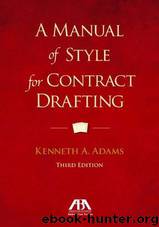A Manual of Style for Contract Drafting, Third Edition by Kenneth A. Adams

Author:Kenneth A. Adams
Language: eng
Format: mobi
Tags: EBC Converted, Business, Law, Education & Reference
Publisher: American Bar Association
Published: 2013-02-01T06:00:00+00:00
11.116
Similarly, it didn’t make sense for the court
to conclude that reasonableness of Meyer’s meaning
was bolstered by the court’s mistaken view that
CUNA could have avoided any ambiguity by using
the word and instead of or. Again, the ostensible
weakness of one alternative meaning doesn’t serve
to bolster the reasonableness of another alternative
meaning.
PRACTICAL CONSIDERATIONS
11.117
The Third Circuit’s analysis of the contract
language at issue in Meyer has lessons to offer
drafters.
The Risks
11.118
Meyer serves as a reminder that if you draft
contracts, it would be reckless of you not to be alert
to ambiguity of the part versus the whole. Unless
you’re attuned to it, the odds are that you’ll be
oblivious to alternative possible meanings unless
they give rise to a dispute.
11.119
And Meyer is one of many cases in which
judges have shown themselves ill-equipped to
analyze issues relating to ambiguity of the part
versus the whole. The judge in Meyer instead relied
on a dictionary definition, something judges are
increasingly doing. See Adam Liptak, Justices
Turning More Frequently to Dictionary, and Not
Just for Big Words, N.Y. Times, June 13, 2011, at
A11. That’s usually a poor substitute for the
semantic acuity required to rigorously parse
537
confusing contract language. So don’t expect judges
to be equipped to sort out in a sensible manner any
part-versus-the-whole mess you create.
Whether to Eliminate Alternative Meanings
11.120
The court’s opinion in Meyer serves as a
reminder that drafters should consider how far to go
in seeking to avoid ambiguity of the part versus the
whole.
11.121
Alternative meanings caused by or and and
are virtually inescapable in contract language.
Consider two components of the definition of “Total
Disability” that weren’t at issue in Meyer. The
definition refers to “a medically determined sickness
or accidental bodily injury.” Does that mean that
disability that is due to both sickness and injury
doesn’t fall within the definition? And consider the
reference to “any occupation for which he is
reasonably qualified by education, training or
experience.” Does that mean that if the member is
qualified because of some combination of education,
training, and experience, it would be irrelevant for
purposes of the definition?
11.122
You could revise contract language to
eliminate the possibility of alternative meanings, but
that would make it more wordy. If any alternative
meanings aren’t reasonable, you could elect to leave
the language as is, on the grounds that the limited
risk of ambiguity doesn’t warrant the extra verbiage.
For example, it would be outlandish to revise the
definition of “Total Disability” to rule out the
538
possible meanings suggested in the immediately
preceding paragraph.
11.123
But you cannot expect courts to be
equipped to determine whether the alternative
meanings of a given provision are reasonable and so
give rise to ambiguity—after all, the court in Meyer
wasn’t.
If
an
alternative
meaning
appears
unreasonable but could result in mischief if
misconstrued by a court, the cautious drafter should
consider redrafting that provision to eliminate the
alternative meaning. The meaning attributed by
Meyer to the language at issue in his dispute perhaps
represents just such an alternative meaning.
11.124
[47] and [48] provide examples of the sort
of judgment calls required when determining
whether to eliminate possible alternative meanings.
Each example expresses two possible meanings, but
anyone inclined to recommend that a drafter
restructure them to eliminate one of those meanings
should consider two factors. First, of the two
possible meanings of each example, one is clearly
the more natural, namely [47a] and [48a]. Second,
given the extra verbiage required to avoid
ambiguity, prose stylists would likely steer clear of
[47a] and [48a].
Download
This site does not store any files on its server. We only index and link to content provided by other sites. Please contact the content providers to delete copyright contents if any and email us, we'll remove relevant links or contents immediately.
The Thirst by Nesbo Jo(6786)
Permanent Record by Edward Snowden(5709)
The Myth of the Strong Leader by Archie Brown(5392)
Spare by Prince Harry The Duke of Sussex(5030)
A Higher Loyalty: Truth, Lies, and Leadership by James Comey(4817)
Secrecy World by Jake Bernstein(4612)
Adulting by Kelly Williams Brown(4458)
The Borden Murders by Sarah Miller(4211)
Machine Learning at Scale with H2O by Gregory Keys | David Whiting(4044)
Killers of the Flower Moon by David Grann(3925)
American Kingpin by Nick Bilton(3731)
Fear by Bob Woodward(3613)
The Secret Barrister by The Secret Barrister(3590)
Future Crimes by Marc Goodman(3490)
The Last Girl by Nadia Murad(3414)
The House on Mango Street by Sandra Cisneros(3371)
Liar's Poker by Michael Lewis(3344)
The Social Psychology of Inequality by Unknown(2918)
Graduate Admissions Essays, Fourth Edition: Write Your Way into the Graduate School of Your Choice (Graduate Admissions Essays: Write Your Way Into the) by Asher Donald(2849)
